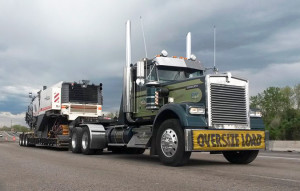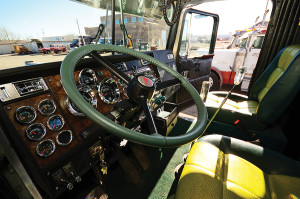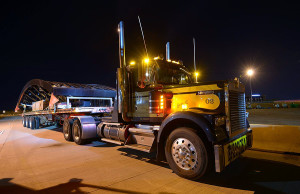 This month, I thought I would take a break from the usual features and bring you up to speed as to what’s been happening with me. A lot has changed over the past year and a half, but I highly recommend making changes in your life when necessary.
This month, I thought I would take a break from the usual features and bring you up to speed as to what’s been happening with me. A lot has changed over the past year and a half, but I highly recommend making changes in your life when necessary.
Just over a year ago I decided to become an owner-operator. And over the last year-and-a-half, it’s had its share of ups and downs and goods and bads, but at the end of the day, I wouldn’t change a thing. Though headaches are constant, and there’s plenty of work keeping the truck going that you’ll never see a dime for, the reward of ownership is worth the long nights and bloody knuckles. Originally pulling a stepdeck, a close friend offered me a job pulling one of his lowboys hauling heavy machinery and running local. I made the jump, and have been happy I did ever since.
 In February of this year, my trusted companion on the road, that red Freightliner cabover with a long wheelbase, spun a main bearing in its N14. Amazingly enough, it happened while in the shop getting a rear-main seal repaired (that’s about as good of timing as you could hope for on a massive mechanical failure like that). Unfortunately, when the main spun, the bearing chattered the saddle. For those less mechanically-inclined, that means the engine will require a line-bore to repair, meaning the saddles which the crankshaft sits in must be re-ground to spec. It’s a complex and expensive procedure.
In February of this year, my trusted companion on the road, that red Freightliner cabover with a long wheelbase, spun a main bearing in its N14. Amazingly enough, it happened while in the shop getting a rear-main seal repaired (that’s about as good of timing as you could hope for on a massive mechanical failure like that). Unfortunately, when the main spun, the bearing chattered the saddle. For those less mechanically-inclined, that means the engine will require a line-bore to repair, meaning the saddles which the crankshaft sits in must be re-ground to spec. It’s a complex and expensive procedure.
I was faced with a choice, as this happened while the old RTO14713 Eaton was being replaced with a RTO16918, as to whether or not the engine could get rebuilt or to park the cabover and buy a second rig. In short, for now, the cabover is parked, waiting to be rebuilt. So, I thought, I might as well jump in with both feet! Today, I’m running a ’90-model W900B Kenworth with a 444XT mechanical Cummins and a set of boxes (6-speed main and 4-speed auxiliary).
 This truck is old, loud, and requires twice the shifting, but there hasn’t been a day yet I’ve been unhappy with the decision I made. Running a mechanical truck with a strictly mechanical engine, along with no air lines on the transmissions and analog gauges, is something you have to experience first-hand to understand. Some of the benefits include immediate throttle response, mechanical simplicity, the ability to work on much of the truck myself, no computers, no sensors and no diagnostic programs. Driving a truck like this is not just peace of mind, it’s more fun, in my opinion, as well. And that’s something I fiercely believe in – having fun at work, whatever it is you do.
This truck is old, loud, and requires twice the shifting, but there hasn’t been a day yet I’ve been unhappy with the decision I made. Running a mechanical truck with a strictly mechanical engine, along with no air lines on the transmissions and analog gauges, is something you have to experience first-hand to understand. Some of the benefits include immediate throttle response, mechanical simplicity, the ability to work on much of the truck myself, no computers, no sensors and no diagnostic programs. Driving a truck like this is not just peace of mind, it’s more fun, in my opinion, as well. And that’s something I fiercely believe in – having fun at work, whatever it is you do.
When you’re getting ready to become an owner-operator, a hundred people will tell you a hundred different things about how and what you should buy. Buy used. Buy new. Buy aerodynamic. Buy classic. Buy short. Buy long. Buy smaller displacement. Buy big power. Big sleeper. Little sleeper. And the list goes on and on. All of those options are important, but considerations should be made in regards to what you’re going to be hauling and what you want.
 You should always make sure the truck is capable of performing the job, but there is no replacement for enjoying the truck you get into on a daily basis. Whether it’s a long-hood classic with big power or an aerodynamic condo-bunk with a 13-liter fuel sipper, simply put, if you don’t enjoy the truck you drive, you’re going to hate going to work. And no amount of added fuel mileage, ergonomic dash or extra storage space will ever make up for that fact.
You should always make sure the truck is capable of performing the job, but there is no replacement for enjoying the truck you get into on a daily basis. Whether it’s a long-hood classic with big power or an aerodynamic condo-bunk with a 13-liter fuel sipper, simply put, if you don’t enjoy the truck you drive, you’re going to hate going to work. And no amount of added fuel mileage, ergonomic dash or extra storage space will ever make up for that fact.
And boy is my old Kenworth ready for the big jobs. With a deep-under auxiliary and 4.44s, she’s walked out 130,000 lbs. gross on 10% grade with ease. There’s still plenty more for me to learn in this industry and I’m sure the headaches aren’t going away any time soon, but for those who are considering the owner-operator route, it’s difficult to describe the satisfaction of running your own gig, of signing your own paycheck, and of controlling your own destiny. So, take a chance and make a change – you will not regret it.
